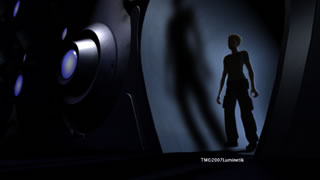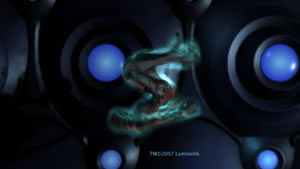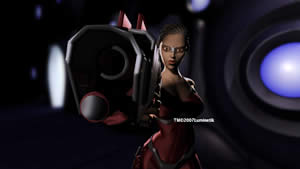Akiko: Can you tell our audience where you are from?
Shuichi: I am from Osaka Japan.
Akiko: When you lived in Japan, when did you realize you wanted to do animation?
Shuichi: I have always loved animation and motion picture production since I was a child. When I discovered this 3D software package called Maya by Autodesk. I started teaching myself all the tools of the package. This began my journey into CGI production.
Akiko: Have you ever studied film making in Japan?
Shuichi: I have never formerly studied film or filmmaking in Japan. I had a passion for it and did a lot of reading of magazines, books, and watching lots and lots of cinema. I was interested in cameras, lighting, cinematography, direction, casting, and all the aspects of film.
cinema. I was interested in cameras, lighting, cinematography, direction, casting, and all the aspects of film.
Akiko: What were some of your favorite animated shows in Japan when you were young?
Shuichi: MOBILE SUIT GUNDAM series, Lupin the 3rd and a work of studio Ghibli , for example, Laputa: Castle in the Sky etc.
Akiko: What are some of your favorite animated movies now?
Shuichi: The Incredibles, The Nightmare Before Christmas, Lilo & Stitch, Laputa: Castle in the Sky, AKIRA
Akiko: Was a lot of American animation available in Japan?
Shuichi: Yes some American Animation was available in Japan like Superman, X-Men, Spiderman, Batman, etc. I liked the superhero cartoons a lot.
Since there is so much Japanese animation in Japan like 75 different cartoons a week. I watched primarily Japanese animation. Akiko: You once said to me, that animation in Japan is very different from animation in the states, can you explain this?
Shuichi: Japanese animation and American animation are different in their stylized motion. Japanese animation style is a little slower with movement between the keyframes while American animation motion moves so much faster and much more dynamic. Japanese animation in many instances exaggerates facial expressions to extremes to get emotion of character across especially in human characters. Japanese animation has a stylized look that is immediately recognizable while some American animation has various styles.
Akiko: What techniques in animation do Japanese animators use?
Shuichi: I have never worked in Japanese animation pipelines as my passion in Japan was creating a style that was a blend of Japanese sensibilities with American Animation. I understand some of the techniques of Japanese animation but they are not that dissimilar to Disney animation techniques. The style is a variation of cultural backgrounds and design choices.
I do notice that when I work in an American animation pipeline I do tend to exaggerate the motion more because Japanese animation does not exaggerate all motion as much as American animation does except of course in facial animation…(smile).
My skill seems to be blending the animation style of Japan as I know it to be with that of American animation to create something new and special.
Akiko: What software packages do you use for animation?
Shuichi: Maya is my main tool.
Akiko: Did you go to school to learn animation or did you learn this skill by constant practice and discipline?
Shuichi: Yes. I went to school for animation for six months but it was only giving me the basics. I have been learning at home since graduation. I am always taking my skill to the next level.
Akiko: How did you find yourself at Luminetik Animation Studio?
Shuichi: I actually saw an ad at Animation World Network (AWN.com). Actually, my friend told me about the article…
Akiko: Can you explain some of the beautiful work you have done at Luminetik from modeling, animation, lighting and your TD skills?
Shuichi: At first I did basic animation on a test project to see what my skill level was so they could fit me in the pipeline in the right place. Once I finished this test, Luminetik was very surprised that I had a special touch they were looking for in their computer animated short “Kuriocity”. I ended up being a lead animator on the character Ruby and refined some rough key frames to help bring Ruby to life. Luminetik was looking for a unique style that was nothing like the typical “pose to pose” style. They wanted something that looked natural but was exaggerated at the right points to seem more life like then realistic motion. I seem to have this style without intention that became a new style of animation for Luminetik. Luminetik has a obsessive detail to motion.
Luminetik was very surprised that I had a special touch they were looking for in their computer animated short “Kuriocity”. I ended up being a lead animator on the character Ruby and refined some rough key frames to help bring Ruby to life. Luminetik was looking for a unique style that was nothing like the typical “pose to pose” style. They wanted something that looked natural but was exaggerated at the right points to seem more life like then realistic motion. I seem to have this style without intention that became a new style of animation for Luminetik. Luminetik has a obsessive detail to motion.
A stylized atmosphere was developed that dared to be dark and mysterious rather then over lit scenes common in animation. The lighting was so dramatic to enhance the animation of the character. There are times when things looks like they go to a complete black in areas and there is not light. All of this is done on purpose. I was used in every part of the pipeline as I seem to know Maya in all the areas that they used Maya for. I have been called “jack of all trades” …LOL.
Akiko: What do you prefer to do more? Lighting, animation, modeling?
Shuichi: I love doing animation, as it is very challenging. I do like to model and create new stylized characters. I don’t think my strength is in lighting but with good direction I seem to grasp the feeling from the Director immediately.
Akiko: What are some of the things that you have found to be hard to do on the current production of Luminetik’s short “Kuriocity”?
Shuichi: Besides English…LOL …The color. I have learned a new skill about color theory and the use of color to convey emotion to the audience. Japanese animation and American animation do vary in these choices. The co-director of the film sat with me to help me build custom palettes. Once it was done, I realized how beautiful it looked had a lot to do with color choices.
Akiko: What do you think of “Kuriocity” now that you have seen it rendered?
Shuichi: I think the camera work, lighting, and the color function make this a very dramatic looking film. I love it.
Akiko: Can you tell us what was the shot you liked the most in the film?
Shuichi: It is a shot that Ruby runs through a hallway with RED CITY.
This shot is so beautiful.
Akiko: Which shot did you think was most difficult?
Shuichi: No shot on this film was easy…I found animating a female character to be a very big challenge. I am a male who in life has dealt primarily with the way men move. I had to learn a lot about how women move in this movie. Ruby also had a very stylized movement due to her character that made it a major hurdle when doing certain types of movement.
I was lucky the co-director on this film is a woman and she helped me to understand how girls move. I know a lot more then I ever did before starting this production.
Akiko: Where do you see the future of animation in motion pictures, games and other content?
Shuichi: The lines between content delivery are blurring. Luminetik decided to build a franchise on the premise that the worlds of the character be seamless. “Kuriocity” is just the first step. I love the direction of where this is going. I want to help build the assets that will help this grow and become one of the first of its kind to create such integration.
Akiko: What do you think is good advice for young animators starting in this business?
Shuichi: Observation is the key. The world around you is always moving even when we aren’t looking. You should always look around at life around you. You should notice the colors, the light and movement. All of these things are fascinating and beautiful. Observe the details of the things around you even if it is not for an artistic purpose. Keep it in your memory so you can appreciate the way life is created everyday. Our best inspiration is here free to observe at all times. Sketch out ideas in your head or on paper. As all things come together, they will give you a point of creation.
Observation is a powerful tool in art.
Akiko: What is your favorite movie?
Shuichi: The movies I mentioned earlier are a few but also STARWARS; X-MEN; The Legend Of 1900, TITANIC; Satomi Hakken-denÅiJAPANESEÅj
Akiko: What is your favorite food?
Shuichi: Japanese foodÅ@and Vietnamese food
Akiko: What is your favorite TV show?
Shuichi: 24, The X-Files
Akiko: Do you like video games?
Shuichi: I love them. I haven’t been playing many games so much since I came to school in LA.
Akiko: What are some of your favorite Japanese video games?
Shuichi: Final Fantasy series, The Legend of Zelda, Far East Of Eden MANJI-MARU, Megami-Tensei(Digital Devil Story)
Akiko: In Japan, do people play more arcade games, console games like the Playstation, Nintendo, or XBOX , PC, or mobile phone games?
Shuichi: People play all kinds of games in Japan. Japanese culture loves games and they are available in every form. They love mobile games because they can play them on the train or on the way to their office.
them on the train or on the way to their office.
Akiko: Do you play American video games?
Shuichi: Not very much…LOL
Akiko: What are some of the differences between Japanese video games and American video games?
Shuichi: My first impression is that Japanese games have a lot more fantasy element while some American games are too serious and real.
Akiko: What would you like to see in the future of video games?
Shuichi: I think that when games become more like Virtual Reality and the merging of cinematic worlds in a virtual world make this evolution exciting. This would be enhanced by multi-player options. In the near future, watching film and video games merge into one entertainment seamless world is something I think is about to happen.

